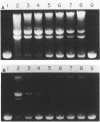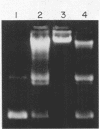Abstract
We developed an assay in which single-strand breakage (ssb) and double-strand breakage (dsb) of intracellular DNA by chemical agents can be accurately quantitated and differentiated. Escherichia coli cells containing plasmid pBR322 DNA were incubated with the antitumor antibiotics bleomycin A2 (BLM A2) or talisomycin A (TLM A). The plasmid DNA was isolated and then analyzed by electrophoresis on 1% agarose gels to separate the following conformational forms of plasmid DNA: (i) native, covalently closed, super helical, form I; (ii) nicked, relaxed circular, form II; and (iii) double-strand broken, linear, form III. Quantitation by densitometric analysis of the gels showed that BLM A2 and TLM A were equally active in terms of the concentrations of drug necessary to reduce equivalent amounts of form I DNA in the cells, whereas in vitro (using isolated pBR322 DNA as a drug substrate) twofold more TLM A than BLM A2 was required to produce an equivalent amount of reduction in form I DNA. TLM A produced more intracellular dsb than did BLM A2. The intracellular dsb activities (dsb/ssb ratio) measured from BLM A2 and TLM A were equivalent to those measured for the respective agents when isolated pBR322 DNA was used as the substrate. In E. coli both ssb and dsb were repaired, but TLM A damage was repaired more slowly and to a lesser extent, which may reflect the relative frequency of dsb.
Full text
PDF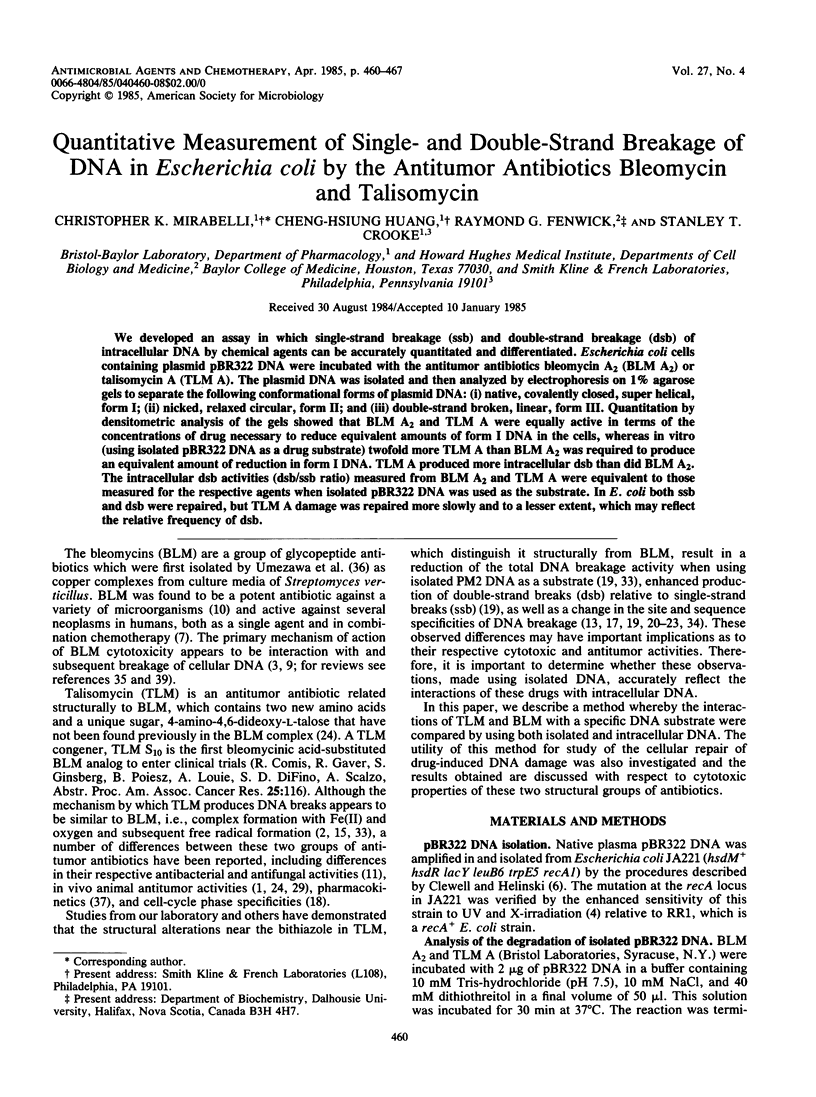
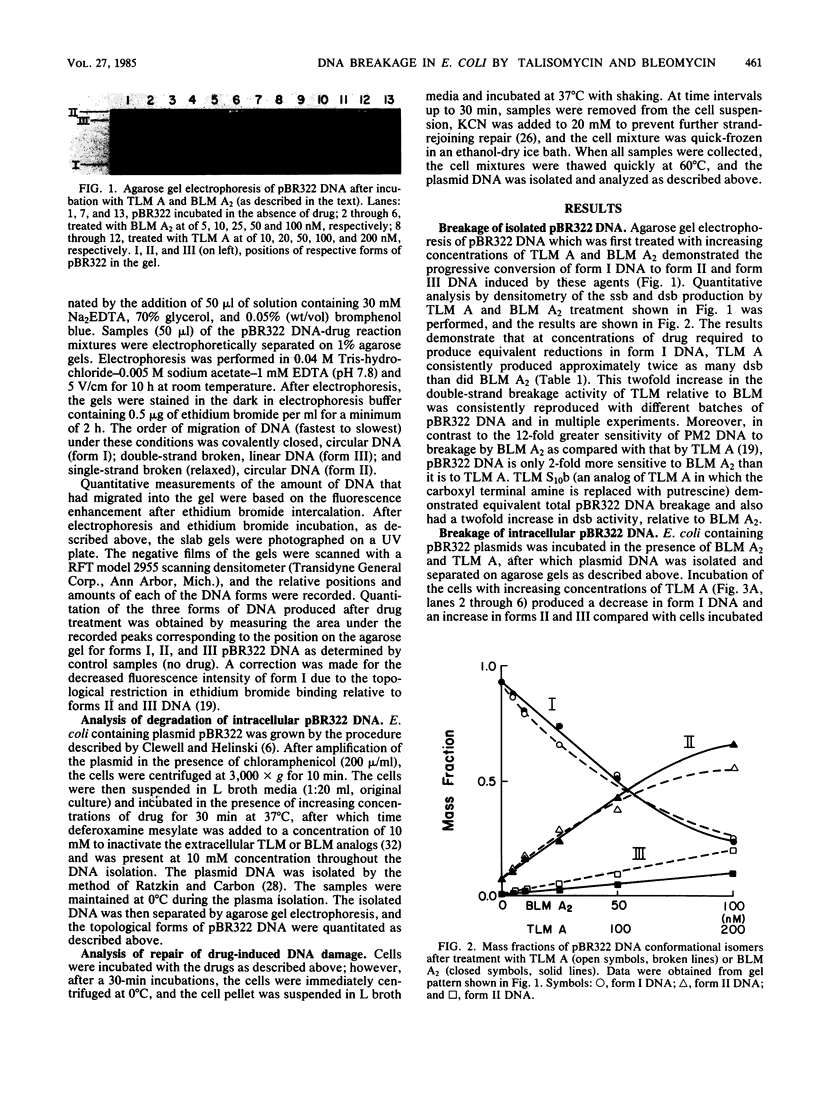
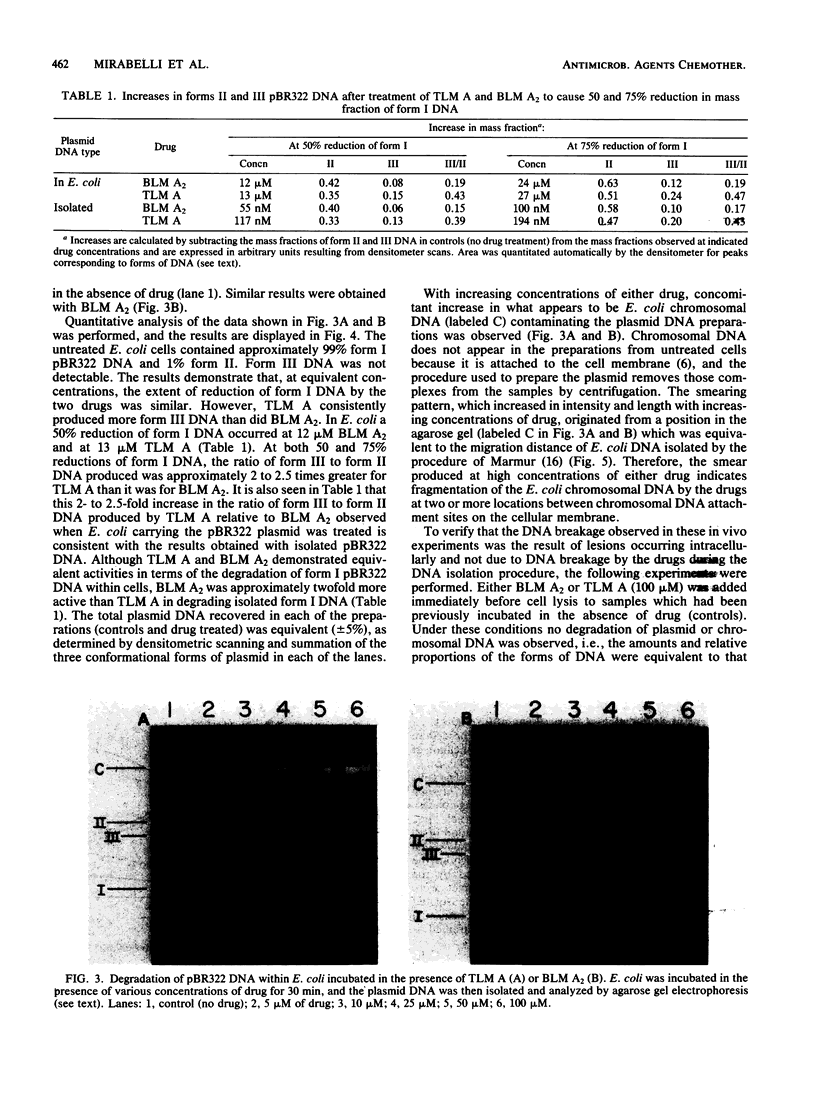
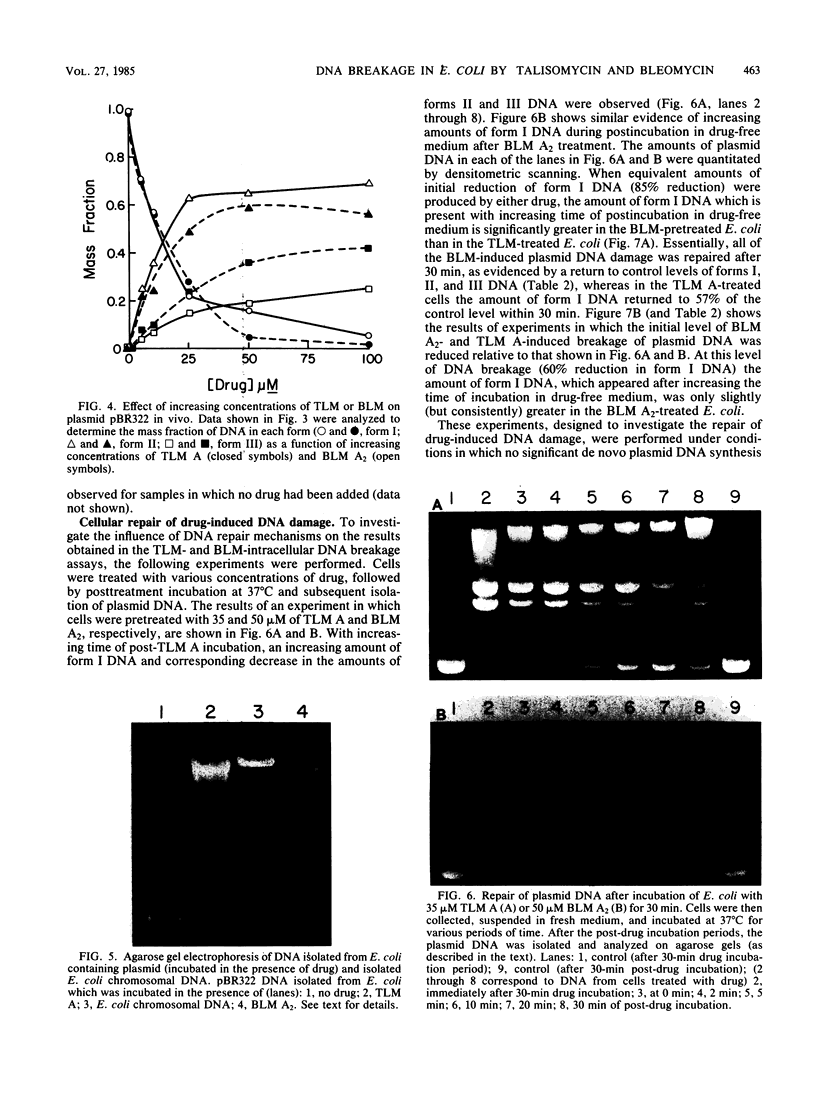
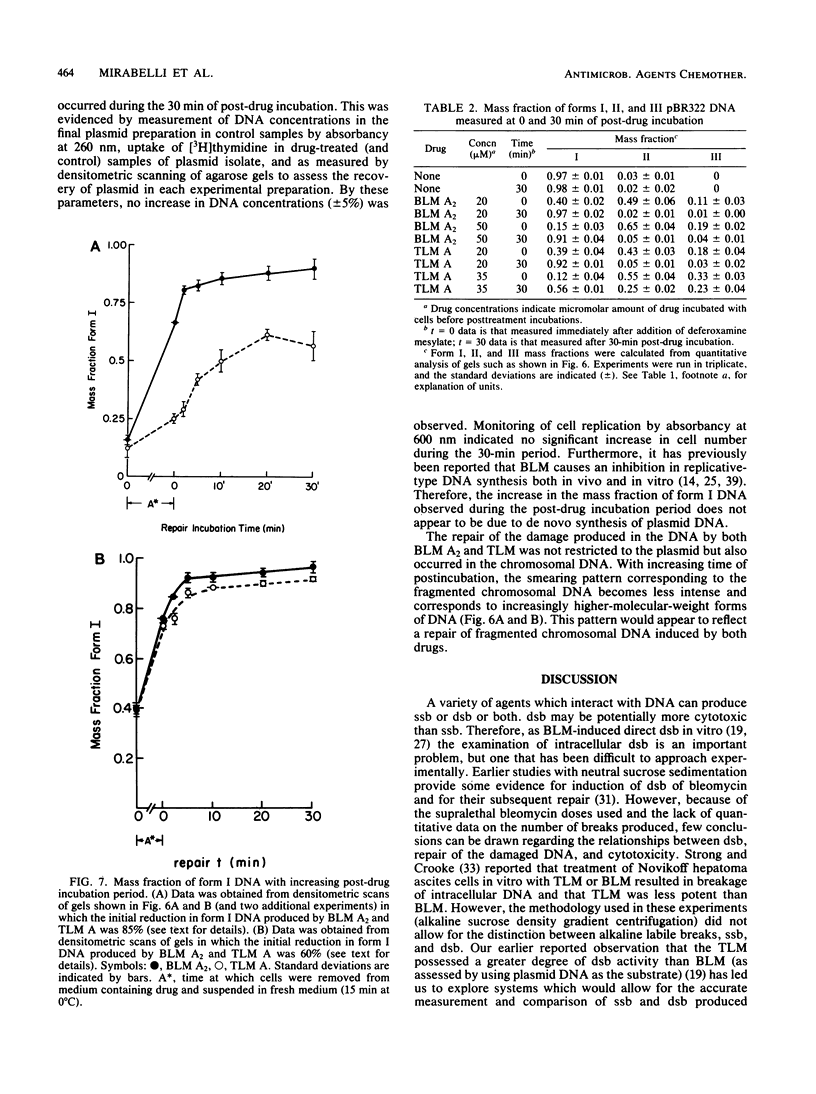
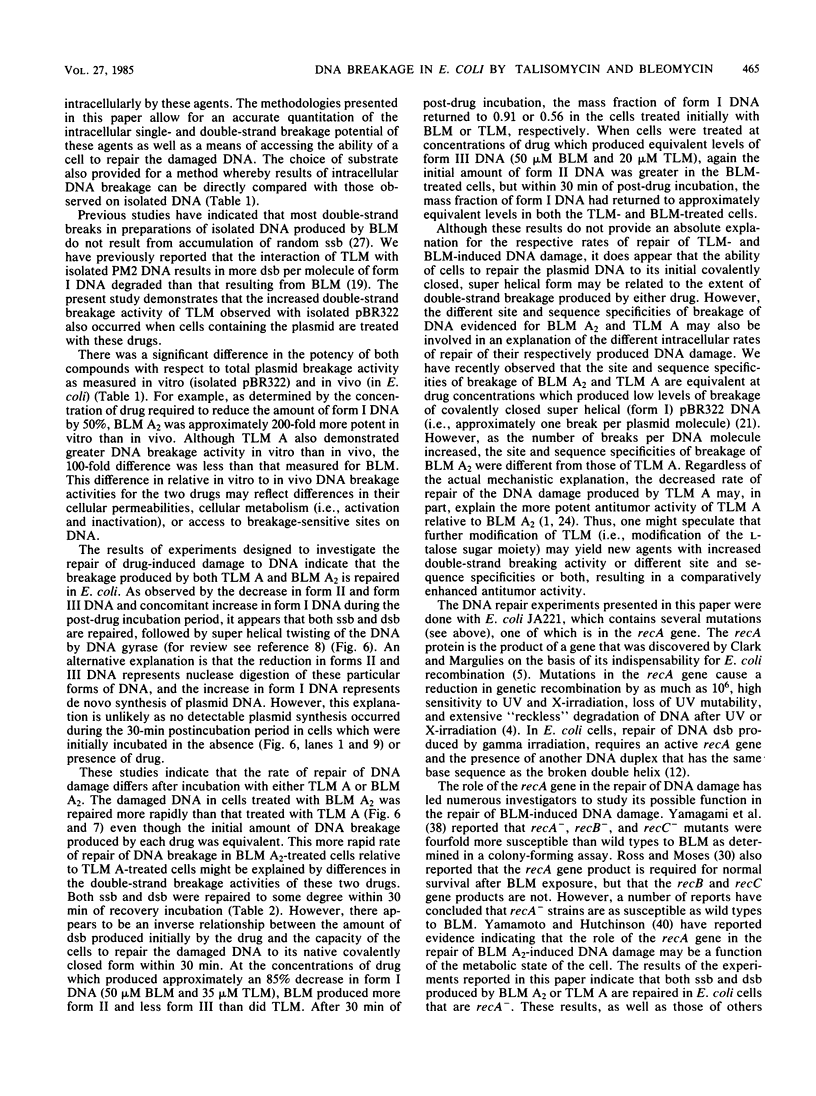
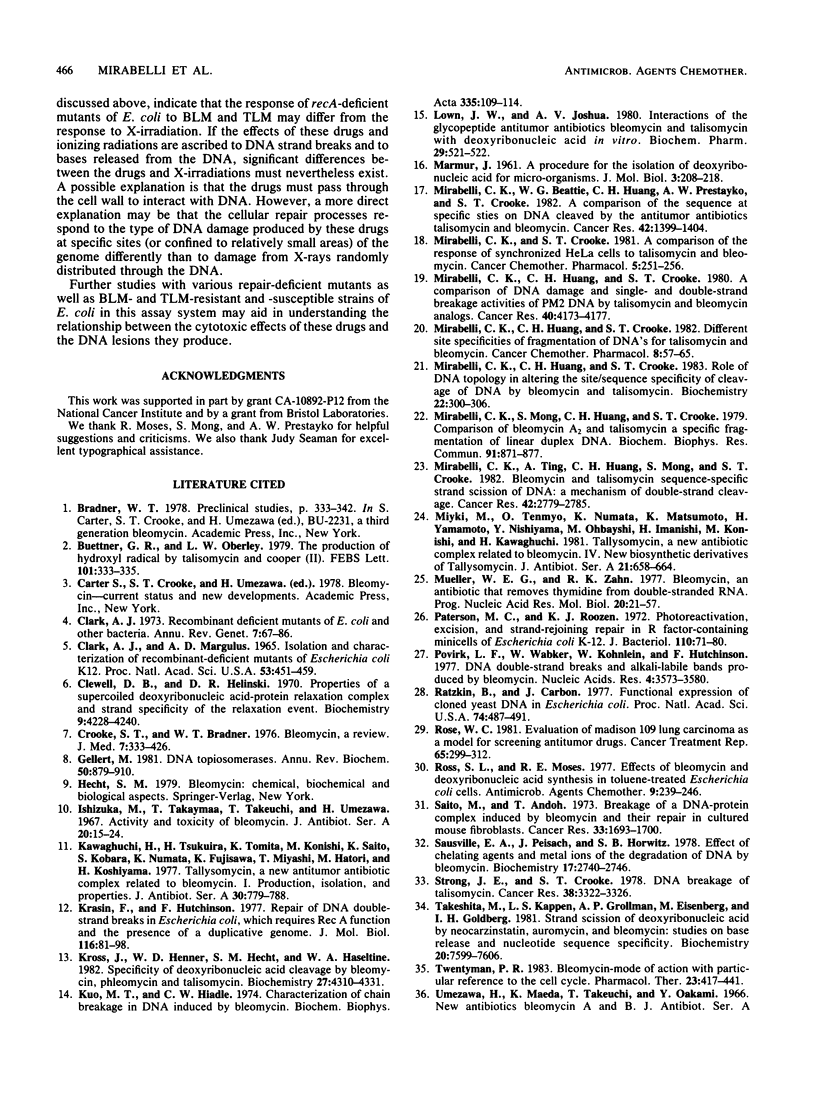
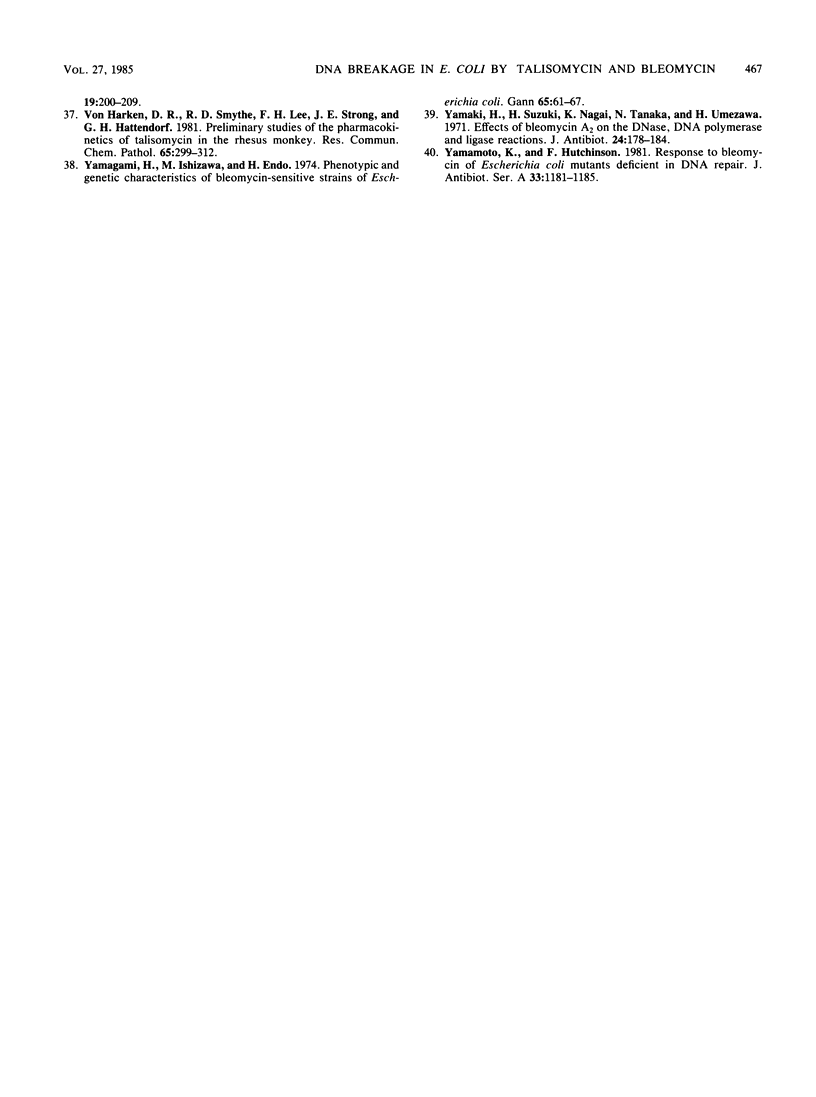
Images in this article
Selected References
These references are in PubMed. This may not be the complete list of references from this article.
- Buettner G. R., Oberley L. W. The production of hydroxyl radical by tallysomycin and copper(II). FEBS Lett. 1979 May 15;101(2):333–335. doi: 10.1016/0014-5793(79)81037-6. [DOI] [PubMed] [Google Scholar]
- CLARK A. J., MARGULIES A. D. ISOLATION AND CHARACTERIZATION OF RECOMBINATION-DEFICIENT MUTANTS OF ESCHERICHIA COLI K12. Proc Natl Acad Sci U S A. 1965 Feb;53:451–459. doi: 10.1073/pnas.53.2.451. [DOI] [PMC free article] [PubMed] [Google Scholar]
- Clark A. J. Recombination deficient mutants of E. coli and other bacteria. Annu Rev Genet. 1973;7:67–86. doi: 10.1146/annurev.ge.07.120173.000435. [DOI] [PubMed] [Google Scholar]
- Crooke S. T., Bradner W. T. Bleomycin, a review. J Med. 1976;7(5):333–428. [PubMed] [Google Scholar]
- Gellert M. DNA topoisomerases. Annu Rev Biochem. 1981;50:879–910. doi: 10.1146/annurev.bi.50.070181.004311. [DOI] [PubMed] [Google Scholar]
- Ishizuka M., Takayama H., Takeuchi T., Umezawa H. Activity and toxicity of bleomycin. J Antibiot (Tokyo) 1967 Jan;20(1):15–24. [PubMed] [Google Scholar]
- Kawaguchi H., Tsukiura H., Tomita K., Konishi M., Saito K. Tallysomycin, a new antitumor antibiotic complex related to bleomycin. I. Production, isolation and properties. J Antibiot (Tokyo) 1977 Oct;30(10):779–788. doi: 10.7164/antibiotics.30.779. [DOI] [PubMed] [Google Scholar]
- Krasin F., Hutchinson F. Repair of DNA double-strand breaks in Escherichia coli, which requires recA function and the presence of a duplicate genome. J Mol Biol. 1977 Oct 15;116(1):81–98. doi: 10.1016/0022-2836(77)90120-6. [DOI] [PubMed] [Google Scholar]
- Kross J., Henner W. D., Hecht S. M., Haseltine W. A. Specificity of deoxyribonucleic acid cleavage by bleomycin, phleomycin, and tallysomycin. Biochemistry. 1982 Aug 31;21(18):4310–4318. doi: 10.1021/bi00261a021. [DOI] [PubMed] [Google Scholar]
- Lown J. W., Joshua A. V. Interactions of the glycopeptide antitumor antibiotics bleomycin and tallysomycin with deoxyribonucleic acid in vitro. Biochem Pharmacol. 1980 Feb 15;29(4):521–532. doi: 10.1016/0006-2952(80)90372-x. [DOI] [PubMed] [Google Scholar]
- Mirabelli C. K., Beattie W. G., Huang C. H., Prestayko A. W., Crooke S. T. Comparison of the sequences at specific sites on DNA cleaved by the antitumor antibiotics talisomycin and bleomycin. Cancer Res. 1982 Apr;42(4):1399–1404. [PubMed] [Google Scholar]
- Mirabelli C. K., Crooke S. T. Comparison of the response of synchronized HeLa cells to talisomycin and bleomycin. Cancer Chemother Pharmacol. 1981;5(4):251–256. doi: 10.1007/BF00434393. [DOI] [PubMed] [Google Scholar]
- Mirabelli C. K., Huang C. H., Crooke S. T. Comparison of DNA damage and single- and double-strand breakage activities on PM-2 DNA by talisomycin and bleomycin analogs. Cancer Res. 1980 Nov;40(11):4173–4177. [PubMed] [Google Scholar]
- Mirabelli C. K., Huang C. H., Crooke S. T. Role of deoxyribonucleic acid topology in altering the site/sequence specificity of cleavage of deoxyribonucleic acid by bleomycin and talisomycin. Biochemistry. 1983 Jan 18;22(2):300–306. doi: 10.1021/bi00271a011. [DOI] [PubMed] [Google Scholar]
- Mirabelli C. K., Huang C. H., Prestayko A. W., Crooke S. T. Structure-activity relationships involved in the site-specific fragmentation of linear duplex DNAs by talisomycin and bleomycin analogs. Cancer Chemother Pharmacol. 1982;8(1):57–65. doi: 10.1007/BF00292872. [DOI] [PubMed] [Google Scholar]
- Mirabelli C. K., Ting A., Huang C. H., Mong S., Crooke S. T. Bleomycin and talisomycin sequence-specific strand scission of DNA: a mechanism of double-strand cleavage. Cancer Res. 1982 Jul;42(7):2779–2785. [PubMed] [Google Scholar]
- Mirabelli C., Mong S., Huang C. H., Crooke S. T. Comparison of bleomycin A2 and talisomycin A specific fragmentation of linear duplex DNA. Biochem Biophys Res Commun. 1979 Dec 14;91(3):871–877. doi: 10.1016/0006-291x(79)91960-0. [DOI] [PubMed] [Google Scholar]
- Miyaki T., Tenmyo O., Numata K., Matsumoto K., Yamamoto H., Nishiyama Y., Ohbayashi M., Imanishi H., Konishi M., Kawaguchi H. Tallysomycin, a new antitumor antibiotic complex related to bleomycin. IV. New biosynthetic derivatives of tallysomycin. J Antibiot (Tokyo) 1981 Jun;34(6):658–664. doi: 10.7164/antibiotics.34.658. [DOI] [PubMed] [Google Scholar]
- Müller W. E., Zahn R. K. Bleomycin, an antibiotic that removes thymine from double-stranded DNA. Prog Nucleic Acid Res Mol Biol. 1977;20:21–57. doi: 10.1016/s0079-6603(08)60469-9. [DOI] [PubMed] [Google Scholar]
- Paterson M. C., Roozen K. J. Photoreactivatiion, excision, and strand-rejoining repair in R factor-containing minicells of Escherichia coli K-12. J Bacteriol. 1972 Apr;110(1):71–80. doi: 10.1128/jb.110.1.71-80.1972. [DOI] [PMC free article] [PubMed] [Google Scholar]
- Povirk L. F., Wübter W., Köhnlein W., Hutchinson F. DNA double-strand breaks and alkali-labile bonds produced by bleomycin. Nucleic Acids Res. 1977 Oct;4(10):3573–3580. doi: 10.1093/nar/4.10.3573. [DOI] [PMC free article] [PubMed] [Google Scholar]
- Ratzkin B., Carbon J. Functional expression of cloned yeast DNA in Escherichia coli. Proc Natl Acad Sci U S A. 1977 Feb;74(2):487–491. doi: 10.1073/pnas.74.2.487. [DOI] [PMC free article] [PubMed] [Google Scholar]
- Rose W. C. Evaluation of Madison 109 lung carcinoma as a model for screening antitumor drugs. Cancer Treat Rep. 1981 Mar-Apr;65(3-4):299–312. [PubMed] [Google Scholar]
- Ross S. L., Moses R. E. Effect of bleomycin on deoxyribonucleic acid synthesis in toluene-treated Escherichia coli cells. Antimicrob Agents Chemother. 1976 Feb;9(2):239–246. doi: 10.1128/aac.9.2.239. [DOI] [PMC free article] [PubMed] [Google Scholar]
- Saito M., Ando T. Breakage of a DNA-protein complex induced by bleomycin and their repair in cultured mouse fibroblasts. Cancer Res. 1973 Jul;33(7):1696–1700. [PubMed] [Google Scholar]
- Sausville E. A., Peisach J., Horwitz S. B. Effect of chelating agents and metal ions on the degradation of DNA by bleomycin. Biochemistry. 1978 Jul 11;17(14):2740–2746. doi: 10.1021/bi00607a007. [DOI] [PubMed] [Google Scholar]
- Strong J. E., Crooke S. T. DNA breakage by tallysomycin. Cancer Res. 1978 Oct;38(10):3322–3326. [PMC free article] [PubMed] [Google Scholar]
- Takeshita M., Kappen L. S., Grollman A. P., Eisenberg M., Goldberg I. H. Strand scission of deoxyribonucleic acid by neocarzinostatin, auromomycin, and bleomycin: studies on base release and nucleotide sequence specificity. Biochemistry. 1981 Dec 22;20(26):7599–7606. doi: 10.1021/bi00529a039. [DOI] [PubMed] [Google Scholar]
- Twentyman P. R. Bleomycin--mode of action with particular reference to the cell cycle. Pharmacol Ther. 1983;23(3):417–441. doi: 10.1016/0163-7258(83)90022-0. [DOI] [PubMed] [Google Scholar]
- Umezawa H., Maeda K., Takeuchi T., Okami Y. New antibiotics, bleomycin A and B. J Antibiot (Tokyo) 1966 Sep;19(5):200–209. [PubMed] [Google Scholar]
- Yamagami H., Ishizawa M., Endo H. Phenotypic and genetic characteristics of bleomycin-sensitive strain of Escherichia coli. Gan. 1974 Feb;65(1):61–67. [PubMed] [Google Scholar]
- Yamaki H., Suzuki H., Nagai K., Tanaka N., Umezawa H. Effects of bleomycin A2 on deoxyribonuclease, DNA polymerase and ligase reactions. J Antibiot (Tokyo) 1971 Mar;24(3):178–184. doi: 10.7164/antibiotics.24.178. [DOI] [PubMed] [Google Scholar]





